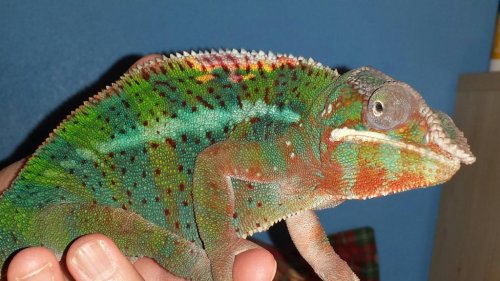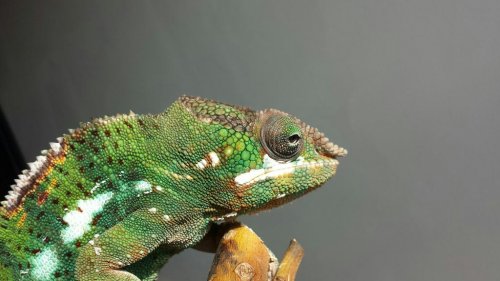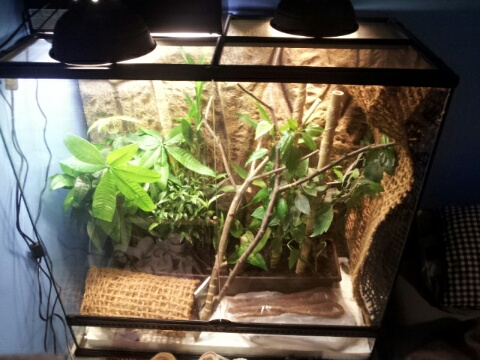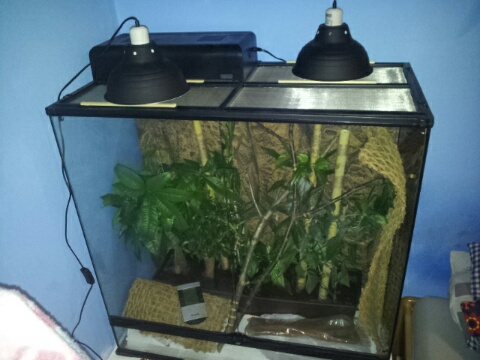Hi guys,
i have a question abou my cham. Here is my chams info:
Chameleon Info:
• Your Chameleon - Panther Chameleon - ambilobe, Male, about 22 months old, 18 months in my care
• Handling - Often - 4-5 times a week
• Feeding - He eats crickets, about 3-4 crickets a day, he eats from my hand (mostly), I give him crickets 6 days in a week, Crickets eat fresh vegetables, oatmeal, raw meat and also water gel for crickets
• Supplements - I gave him calcium and vitamins recommended by his parents breeder. He used them for many years without any problems. Almost every breeder in my coutry use the same vitamins and calcium combination. The week schedule - 2 x vitamins, 4 x calcium
• Watering - I have Exo terra Monsoon misting system, I also mist the cage extra 3-4 times a day. My cham drinks 1-2 times a week - I give him water drops (I haven´t seen him drinking alone for many weeks - he prefers to lick everything, but don´t drinking from leaves
• Fecal Description - Never been tested for parasites, he poo once in about 8-10 days, the poo is huge, but normal color and consistence.
• History - Nothing
Cage Info:
• Cage Type - I had Exo terra glass cage - 36x18x36
• Lighting - 2 x exo terra UVB 100 - 26W tropical bulb, 2 x 40 W spot light bulb, The lights turn on at 7 am, turn off at 6 pm - in winter
• Temperature - basking spot - about 86 F, middle - 77 F, floor - 73, at night - about 69-70 F
• Humidity - max about 75 - 80 after misting, min about 55 %
• Plants - I have only live plants - mostly hibiscus or some edible plants (don´t know names)
• Placement - The cage is in bedroom, nothing is near, the top of the cage is 4,9 feet high (1,5 meter)
• Location - Czech Republic, central Europe - that´s why I use glass cage - it will be hard to keep humidity and temperature in screen cage.
Current Problem
My cham has some wierd stains on skin on his back (see pics). He had it from December 2014, but now it looks different. I think, it should be some pigment problem but i wanted to ask here on forum what do you think about that.
i have a question abou my cham. Here is my chams info:
Chameleon Info:
• Your Chameleon - Panther Chameleon - ambilobe, Male, about 22 months old, 18 months in my care
• Handling - Often - 4-5 times a week
• Feeding - He eats crickets, about 3-4 crickets a day, he eats from my hand (mostly), I give him crickets 6 days in a week, Crickets eat fresh vegetables, oatmeal, raw meat and also water gel for crickets
• Supplements - I gave him calcium and vitamins recommended by his parents breeder. He used them for many years without any problems. Almost every breeder in my coutry use the same vitamins and calcium combination. The week schedule - 2 x vitamins, 4 x calcium
• Watering - I have Exo terra Monsoon misting system, I also mist the cage extra 3-4 times a day. My cham drinks 1-2 times a week - I give him water drops (I haven´t seen him drinking alone for many weeks - he prefers to lick everything, but don´t drinking from leaves
• Fecal Description - Never been tested for parasites, he poo once in about 8-10 days, the poo is huge, but normal color and consistence.
• History - Nothing
Cage Info:
• Cage Type - I had Exo terra glass cage - 36x18x36
• Lighting - 2 x exo terra UVB 100 - 26W tropical bulb, 2 x 40 W spot light bulb, The lights turn on at 7 am, turn off at 6 pm - in winter
• Temperature - basking spot - about 86 F, middle - 77 F, floor - 73, at night - about 69-70 F
• Humidity - max about 75 - 80 after misting, min about 55 %
• Plants - I have only live plants - mostly hibiscus or some edible plants (don´t know names)
• Placement - The cage is in bedroom, nothing is near, the top of the cage is 4,9 feet high (1,5 meter)
• Location - Czech Republic, central Europe - that´s why I use glass cage - it will be hard to keep humidity and temperature in screen cage.
Current Problem
My cham has some wierd stains on skin on his back (see pics). He had it from December 2014, but now it looks different. I think, it should be some pigment problem but i wanted to ask here on forum what do you think about that.









